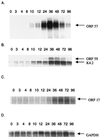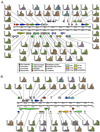Transcription program of human herpesvirus 8 (kaposi's sarcoma-associated herpesvirus)
- PMID: 11312356
- PMCID: PMC114239
- DOI: 10.1128/JVI.75.10.4843-4853.2001
Transcription program of human herpesvirus 8 (kaposi's sarcoma-associated herpesvirus)
Abstract
Human herpesvirus 8 (HHV-8), a gammaherpesvirus implicated in Kaposi's sarcoma, primary effusion lymphoma, and Castleman's disease, encodes several pathogenically important cellular homologs. To define the HHV-8 transcription program, RNA obtained from latently infected body cavity-based lymphoma 1 cells induced to undergo lytic replication was used to query a custom HHV-8 DNA microarray containing nearly every known viral open reading frame. The patterns of viral gene expression offer insights into the replication and pathogenic strategies of HHV-8.
Figures




References
-
- Aoki Y, Jaffe E S, Chang Y, Jones K, Teruya-Feldstein J, Moore P S, Tosato G. Angiogenesis and hematopoiesis induced by Kaposi's sarcoma-associated herpesvirus-encoded interleukin-6. Blood. 1999;93:4034–4043. - PubMed
-
- Arvanitakis L, Geras-Raaka E, Varma A, Gershengorn M C, Cesarman E. Human herpesvirus KSHV encodes a constitutively active G-protein-coupled receptor linked to cell proliferation. Nature. 1997;385:347–350. - PubMed
-
- Ausubel F M, Brent R, Kingston R E, Moore D D, Seidman J G, Smith J A, Struhl K. Current protocols in molecular biology. New York, N.Y: Greene Publishing and Wiley Interscience; 1999.
-
- Bittner M, Meltzer P, Chen Y, Jiang Y, Seftor E, Hendrix M, Radmacher M, Simon R, Yakhini Z, Ben-Dor A, Sampas N, Dougherty E, Wang E, Marincola F, Gooden C, Lueders J, Glatfelter A, Pollock P, Carpten J, Gillanders E, Leja D, Dietrich K, Beaudry C, Berens M, Alberts D, Sondak V. Molecular classification of cutaneous malignant melanoma by gene expression profiling. Nature. 2000;406:536–540. - PubMed
-
- Boshoff C, Endo Y, Collins P D, Takeuchi Y, Reeves J D, Schwieckart V L, Siani M A, Sasaki T, Williams T J, Gray P W, Moore P S, Chang Y, Weiss R A. Angiogenic and HIV-inhibitory functions of KSHV-encoded chemokines. Science. 1997;278:290–295. - PubMed
Publication types
MeSH terms
LinkOut - more resources
Full Text Sources

